17 Types of Succulents: Pros & Cons (With Pictures)
-
Pete Ortiz
- Last updated:
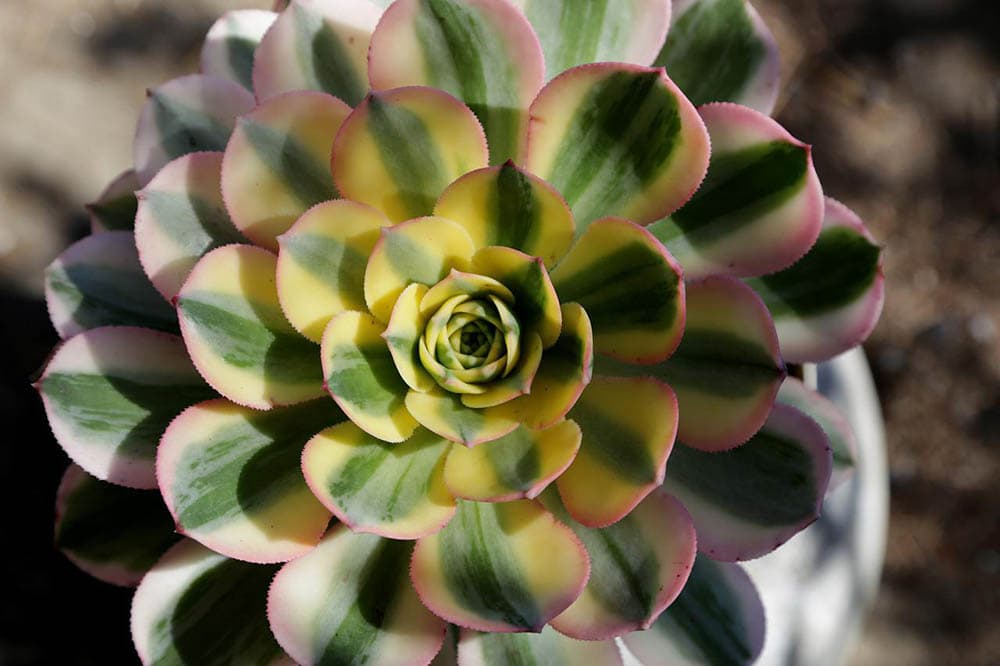
If you are looking for a way to spice up your garden or home with a beautiful collection of plants, but you do not have much time to take care of them, then succulents are perfect for you. These plants have stunning rosettes of leaves, look lovely and colorful wherever you plant them and require minimum maintenance and effort.
Read more below from our list of the most popular and most beautiful types of succulents.
The 17 Types of Succulents
1. Zebra Plant
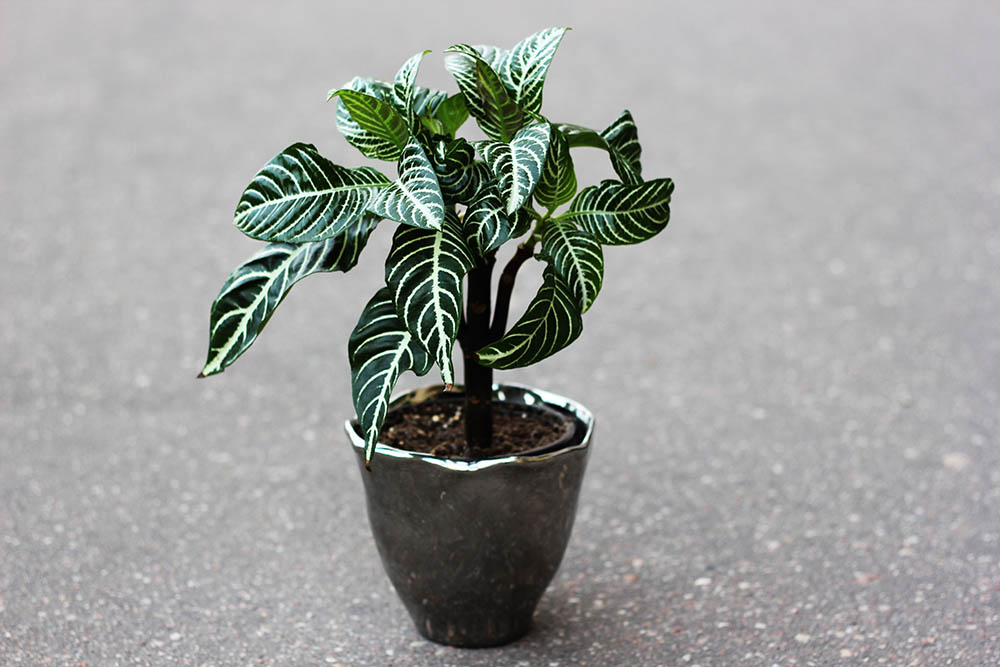
| Botanical name | Aphelandra Squarrosa |
| Native area | Brazil |
| Soil type | Moist soil |
The Zebra Plant is usually grown indoors. It is distinctive for its dark green leaves decorated with white stripes, which is how this unique succulent got its name. The Zebra Plant is a slow-growing succulent that blooms at the end of summer and the beginning of fall. It grows tall bracts, colored in shades of gold.
Because it originates from Brazil, this succulent thrives and grows well in warm and humid areas, in partial or direct sunlight.
- It can be grown indoors
- It can live up to a decade if properly maintained
- Eccentric appearance
- Requires specifically warmer temperatures to thrive
- Direct sunlight may burn the leaves
- If overwatered leaves may fall off
2. Haworthia
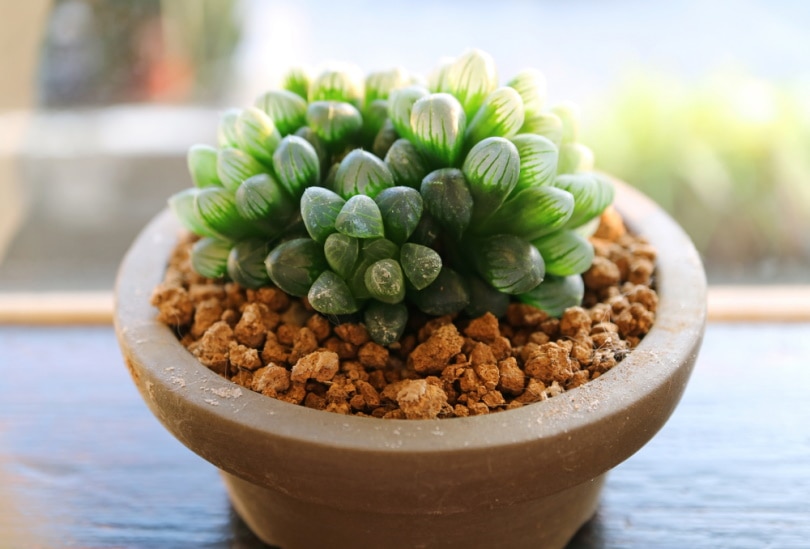
| Botanical name: | Haworthia |
| Native area: | South Africa |
| Soil type: | Well-drained, sandy soil |
Haworthia is a low-growing succulent that is very easy to grow and maintain. It grows fleshy, dark green leaves that are topped with white freckles. Haworthia is native to South Africa and requires full sunlight and well-drained soil to grow well. These succulents can make a lovely addition to your home and you can even plant them in your garden.
It is best to water them frequently, but not to overwater them or let them dry out.
- Great for growing indoors
- Can be grown in the garden
- Low-maintenance
- Leaves may turn yellow
- Leaves can shrivel if underwatered
3. Echeveria

| Botanical name: | Echeveria |
| Native area: | Mexico, Central America, and South America |
| Soil Type: | Well-drained soil |
The Echeveria plant is a very common, slow-growing succulent. It is beautiful, low-maintenance, and shaped into a rosette with fleshy, plump leaves. The rosette shape makes this succulent resemble a flower, so they are adored for decorating. The Echeveria plant looks its best during spring, but in autumn they get beautiful colors too. This succulent will thrive in dry environments where good air circulation is provided.
- Low-maintenance
- Very attractive colorful rosette
- It can thrive both outdoors and indoors
- Susceptible to pests
- It can rot if overwatered
4. Donkey’s Tail
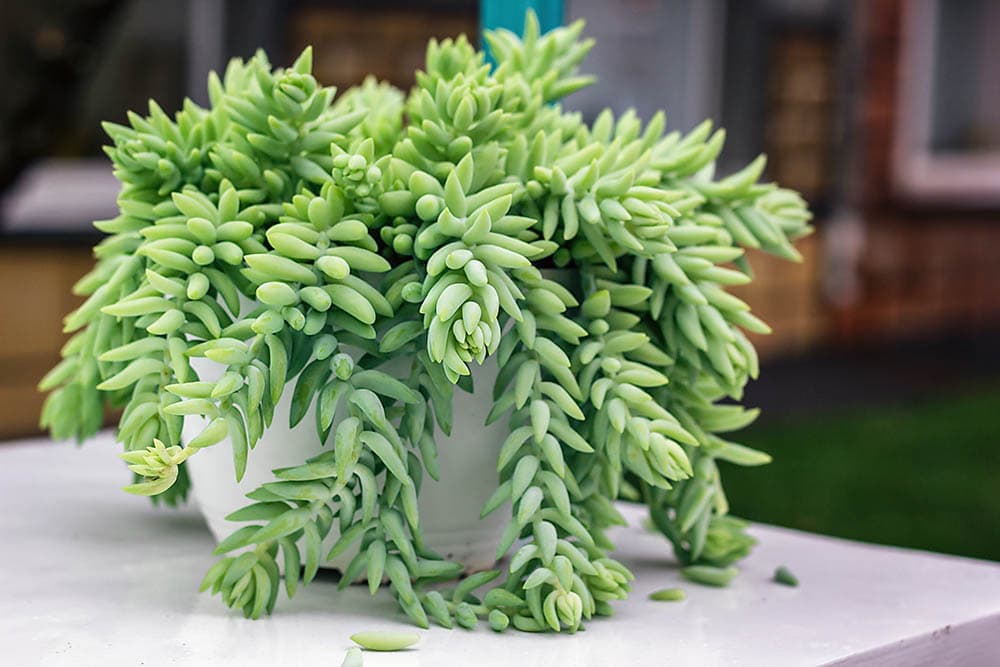
| Botanical name: | Sedum Morganianum |
| Native area: | North America |
| Soil Type: | Sandy and loamy |
The Donkey’s Tail is a unique succulent covered with plump, blue-green leaves that interlock and graciously fall over the side of the plant’s pot. This succulent can be very fragile and tricky to grow. Donkey’s Tail needs to be watered frequently—unlike other succulents—for the leaves to stay attractive and healthy.
While it thrives in sunlight, direct sun exposure might burn the leaves. It is best to place it in direct sunlight in the mornings and bright shade later during the day. This succulent will look great on a balcony, a patio, a sunny window, or any other place where it will receive enough sunlight.
- Very attractive, unique leaves
- It can grow both indoors and outdoors
- Low-maintenance
- Prone to aphids
- Fragile stem
5. Jade Plant
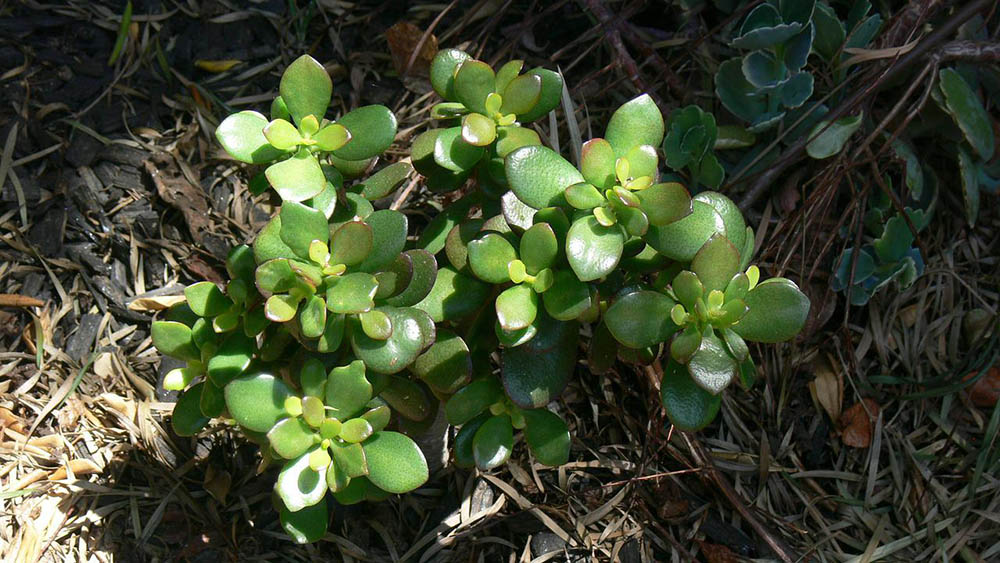
| Botanical name: | Crassula Ovata |
| Native area: | Well-drained soil |
| Soil Type: | South Africa |
The Jade Plants is a type of succulent that’s best to keep as a houseplant and very easy to grow indoors. This succulent is distinctive by its tiny tree-like appearance, and the fleshy oval-shaped leaves make it a great addition to any home. The Jade succulent symbolizes good fortune and luck and is very popular in homes, gardens, and even offices. They thrive in the warm and dry spaces that most indoor areas usually maintain.
When the plant is growing, it is essential to water it regularly during spring and summer. When winter comes, this plant becomes dormant, and too much watering can hurt it. If appropriately maintained, the Jade Plant can live healthy for a long time.
- Easily maintained
- It has a very long life span
- Convenient for growing indoors
- Leaves may drop off
- Prone to pests like mealybug
6. Aloe Vera
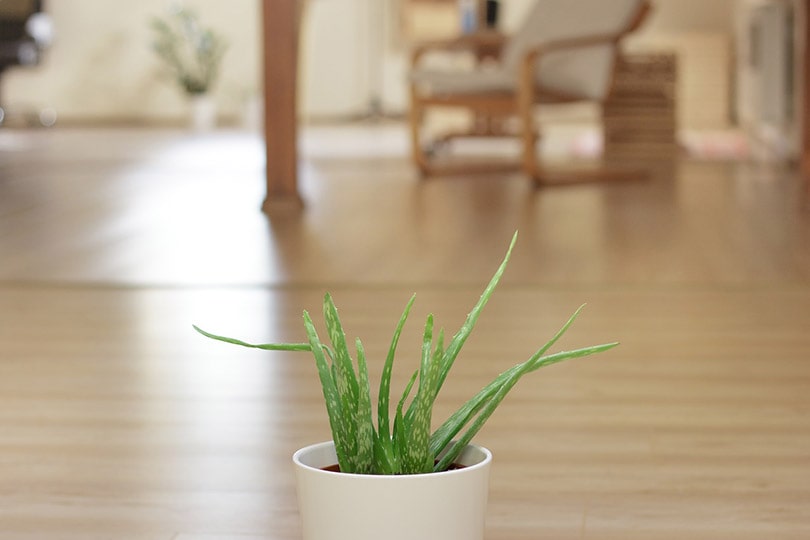
| Botanical name: | Aloe Vera |
| Native area: | South-east Arabian Peninsula |
| Soil Type: | Sandy |
The Aloe Vera is an interesting and popular succulent that is easy to grow outdoors and indoors. They are famous for the leaves’ juice, which can be widely used as alternative medicine. It can reduce pain caused by burns and have a soothing effect on the skin.
Aloe Vera usually thrives in bright areas, and you should maintain watering in proportion to the sunlight it receives. A healthy and mature Aloe Vera will produce dozens of red and yellow flowers if planted outdoors.
- Can be used as medicine
- Can grow outdoors and indoors
- Great as indoor decoration
- Susceptible to mealybugs and scale
- Prone to root rot
7. Panda Plant
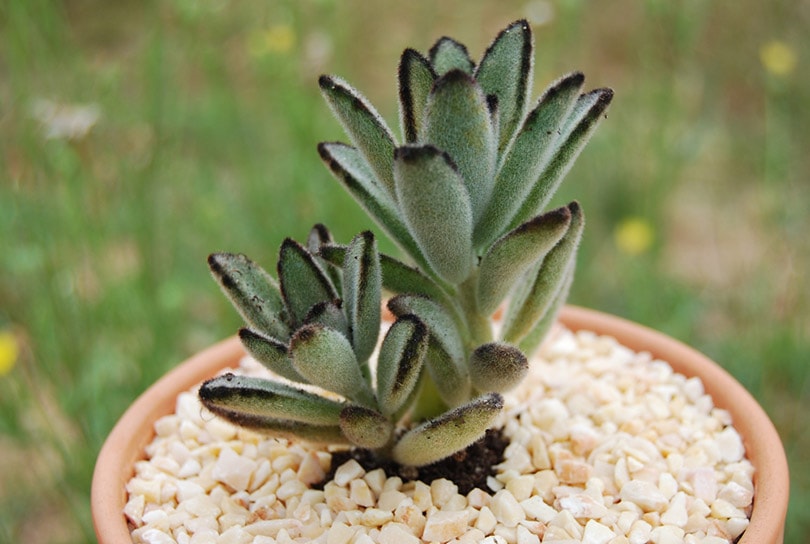
| Botanical name: | Kalanchoe Tomentosa |
| Native area: | Madagaskar |
| Soil Type: | Well-drained soil |
The Panda Plant is a low-growing succulent that makes a beautiful addition to any home when planted inside. The plant’s leaves have a coat of fine hairs that give it a velvety and fuzzy appearance. The leaves are grayish-green with brown speckles on the tips, making this succulent distinctive.
Because the Panda Plant is a succulent, it has thick leaves that store water, and you thus don’t need to water it as frequently.
- Easy to maintain
- Unique furry appearance
- Fun and suitable for kids
- Stores excess water in the leaves
- May need a grow light to thrive indoors
- Leaves are toxic to humans and pets
- If overwatered, leaves turn yellow and mushy
8. Snake Plant

| Botanical name: | Dracaena Trifasciata |
| Native area: | West Africa |
| Soil Type: | Well-drained and sandy soil |
The Snake Plant is a type of succulent that is recognized for its attractive appearance and its ability to improve air quality. Snake Plants are distinctive with their upright, evergreen leaves, which come in various colors but are usually green with yellow stripes. Its erect, evergreen sword-shaped leaves distinguish it.
Snake Plants are popular as houseplants because they are attractive, easy to care for, and require little water to live. They can survive in extreme temperatures plus they can thrive in bright light or shaded areas.
- Drought-resistant
- It can survive in extreme weather
- Low-maintenance
- Has health benefits
- Evergreen
- Toxic for humans and pets
- It may become invasive in some areas
9. Golden stonecrop

| Botanical name: | Sedum acre ‘Aureum’ |
| Native area: | Eastern and East-Central U.S. |
| Soil Type: | Well-drained loamy or sandy soil |
The Golden Stonecrop, also known as the Golden Carpet, is a moss-like succulent that is best to plant outside due to its dense, carpet-like foliage. This succulent forms a thick mat of tiny green leaves, and their tips will turn yellow in the spring. In early summer, this succulent will bloom with yellow star-shaped flowers.
Stonecrop is an excellent groundcover plant, especially in hot, dry conditions with poor soil. It is a versatile plant to grow that requires minimum effort to maintain.
- Fast grower
- Evergreen
- Can work as a lawn replacement
- Cold and wet soil can harm them
- Leaves may flop to the sides
10. Whale’s Tongue Agave

| Botanical name: | Agave Ovatifolia |
| Native area: | North-eastern Mexico |
| Soil Type: | Chalk, loamy and sandy soil |
Whale’s Tongue Agave is an evergreen succulent that grows a beautifully rounded rosette with cup-shaped leaves. Along the leaves’ edges, small teeth are tightly distributed. The succulent is a slow-growing yet eye-catching plant that can grow well even in a state of neglect.
The Whale’s Tongue species is a resilient crop that does not need constant attention. It is effortless to cultivate this plant since it can survive under extreme conditions. They prefer soil that is a bit sandy and rocky.
- Great for xeriscape gardens
- Low-maintenance
- Pest and disease resistant
- Grows well outdoors
- May be prone to snout weevil
- Prone to root rot
11. Ball Cactus
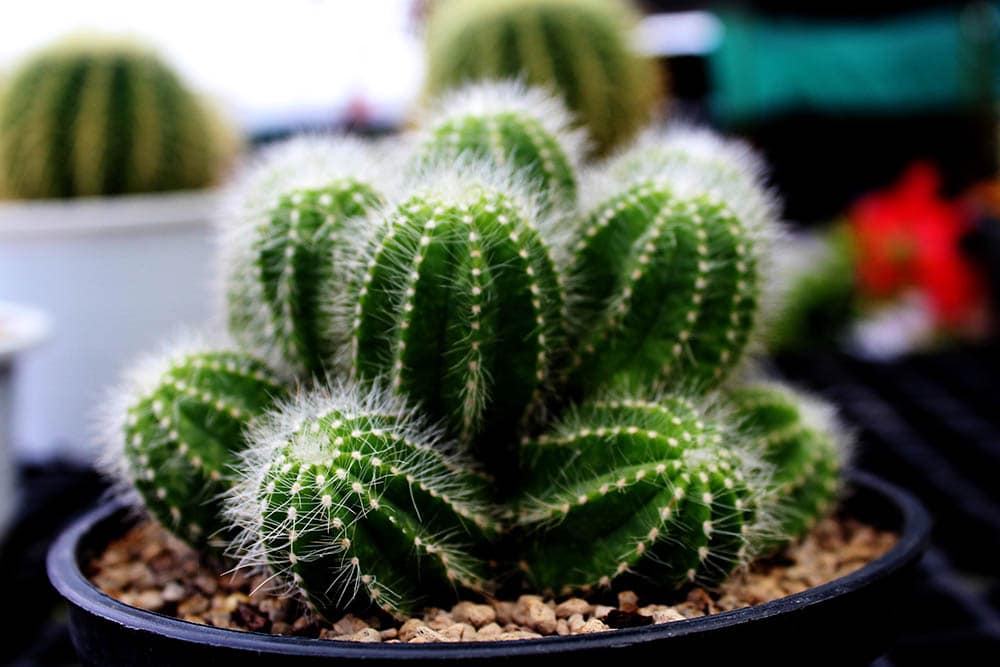
| Botanical name: | Parodia Magnifica |
| Native area: | Grasslands of South America |
| Soil Type: | Sandy, well-drained soil |
Parodia Magnifica begins its life as a spherical spiky structure, but it settles into a near columnar form as it grows older. The entire stem is coated with yellow spines, while the branch itself is green or has a blue-green tint. Rounded Ball Cacti are commonly planted for aesthetic appeal, both in gardens or inside.
Watering is recommended but only as much as needed. Succulents don’t like a lot of water, so don’t expect them to drink a lot of it.
- Low-maintenance
- It can withstand many different temperatures
- Can have a very long life
- May turn soft
- Prone to pests like whiteflies, mealybugs, and aphids
- Nicks in the leaves may appear where bacteria can enter
12. Pigs Ear
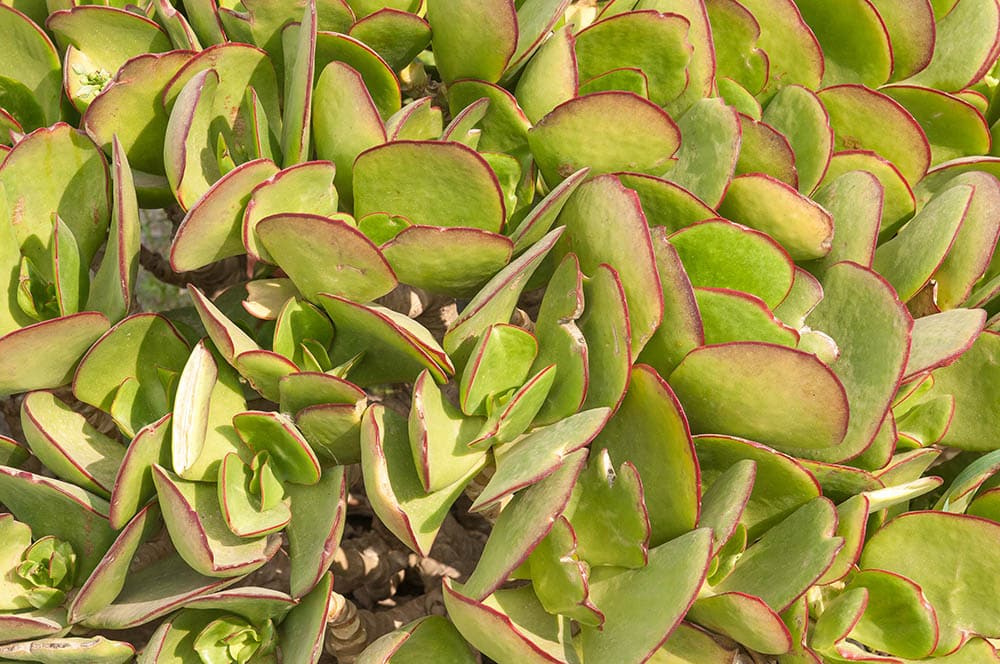
| Botanical name: | Cotyledon Orbiculata |
| Native area: | South Africa |
| Soil Type: | Well-drained, sandy soil |
The Pig’s Ear Plant is a succulent houseplant that is very easy to cultivate. Pig’s Ear gets its name from the shape of the leaf, which resembles that of a pig’s ear. Pig’s Ear features huge spherical-shaped silver leaves with a red border. The leaves are grey-green and coated in a white powdered material that helps them with light reflection and water conservation.
It’s a fantastic long-lasting potted plant for outdoor garden areas, and you may even carry it inside during winter.
- Has medical uses
- Great for beginner gardeners
- Long lasting
- Susceptible to root rot
- Cannot thrive in shady places
- May be prone to mealy bugs and aphids
13. Zwartkop
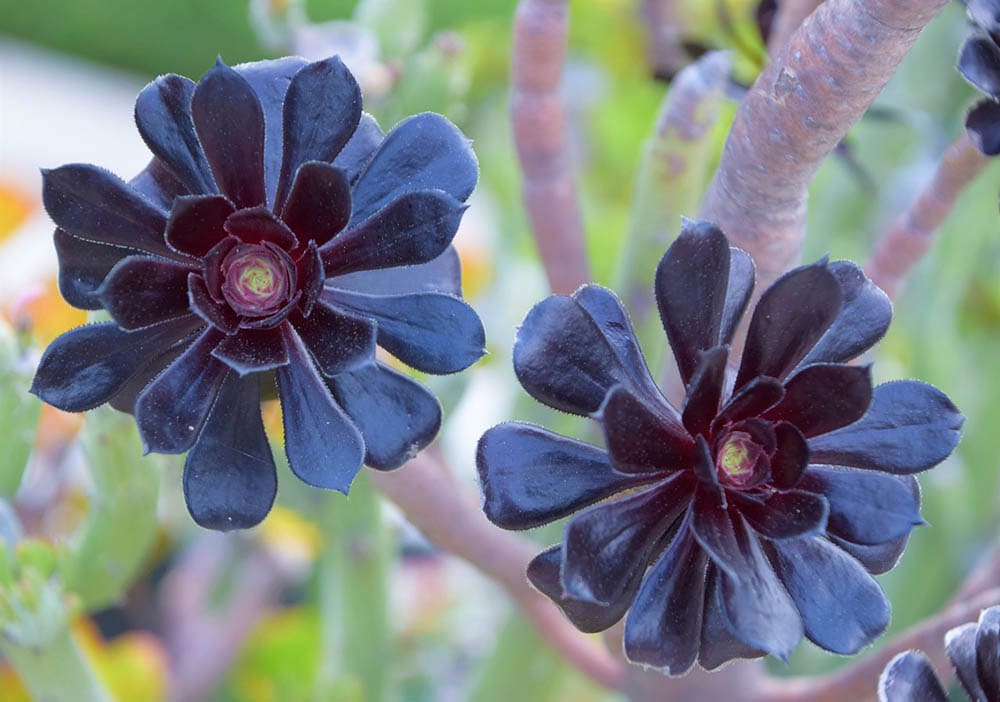
| Botanical name: | Aeonium |
| Native area: | The Canary Islands and North Africa |
| Soil Type: | Loamy and sandy |
The succulent Aeonium ‘Zwartkop’ has fleshy, spherical blooms. It is distinguished by the blossom’s color, which is a dark, nearly black purple. It’s ideal for use as dry borders or in pots on a bright porch. Grow Aeonium ‘Zwartkop’ in well-drained soil or containers in a sunny, protected location for optimal results.
These plants look great in terracotta pots and are perfect for any outdoor or indoor setting.
- Easy to propagate
- Can grow up to 6,5 feet
- Easy to care for
- Susceptible to rot
- Loses leaves in winter
14. String of Pearls
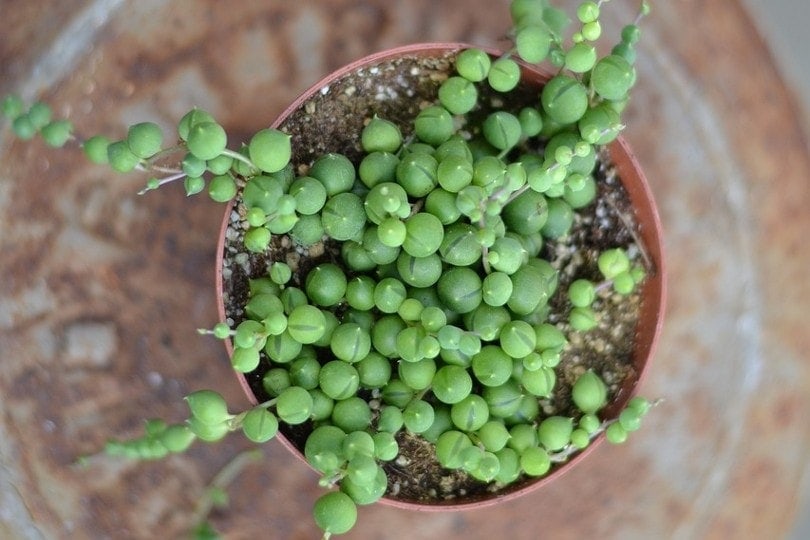
| Botanical name: | Senecio Rowleyanus |
| Native area: | Africa |
| Soil Type: | Well-drained soil |
The “String of Pearls” is a unique species of succulent. It’s a typical houseplant that can serve as an attractive focal point. With its fleshy green, pea-like leaves that fall over the sides of containers, it resembles a beaded necklace. In bright light the string of pearls plant flourishes. This plant, like other succulent plants, needs very little maintenance.
- One of the most unique succulent shapes
- Can grow up to 3 feet
- Fast-growing
- Easy to maintain
- Susceptible to mealy bugs
- Toxic for pets
15. Sunburst
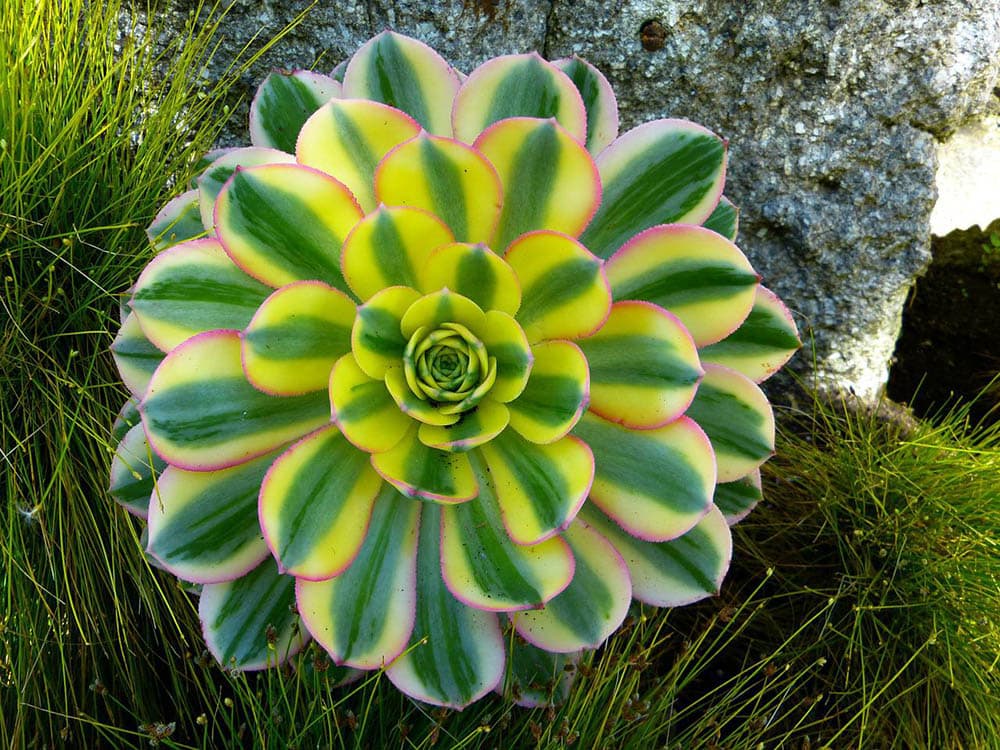
| Botanical name: | Aeonium ‘Sunburst’ |
| Native area: | Canary Islands |
| Soil Type: | Well-drained, sandy soil |
‘Sunburst’ is a colorful, branching type of succulent. It has white and green leaves with pink borders that become red in the sunlight. The greenish and pale yellow leaves have pink edges that become intensely red when exposed to direct sunlight. In the summer, expect to see white blossoms.
“Sunburst” may be cultivated inside if given adequate light, despite its preference for full sun. Sunburst, like all Aeoniums, bruises quickly, but the bruising cannot hurt the plant in any way. Their huge rosette leaves resemble a beam of sunlight, which is how they got this lovely name.
- Easy to grow and propagate
- Turns pink when it gets lots of sunlight
- Evergreen
- Drought-tolerant
- Slugs, scale insects, and spiders may attack it
- Contains sap that is toxic to humans and animals
16. Sweetheart Hoya
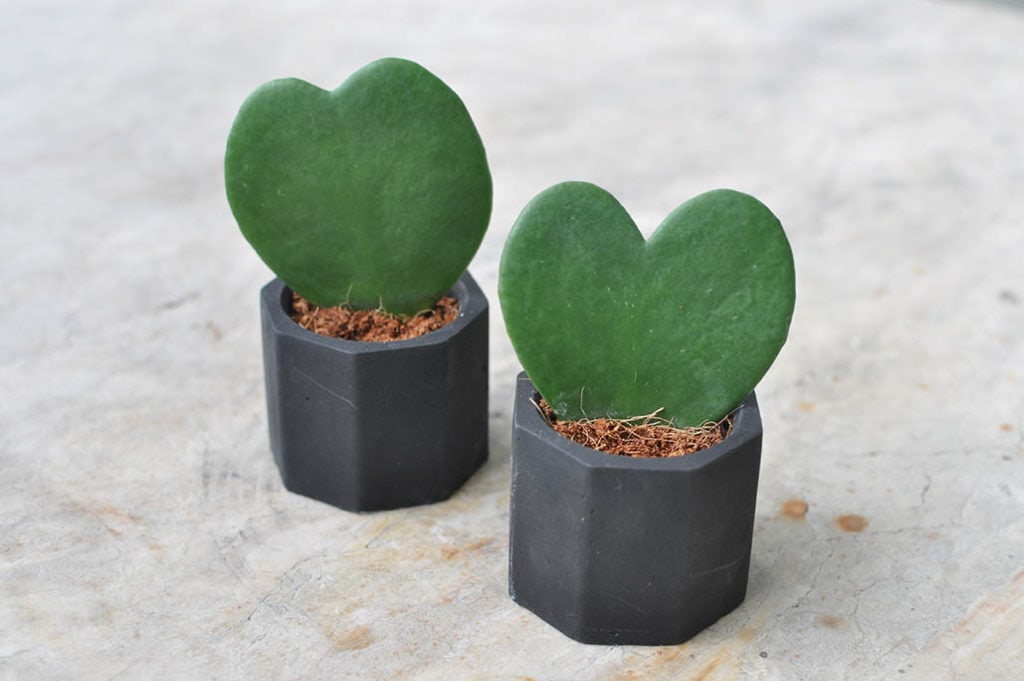
| Botanical name: | Hoya |
| Native area: | Southern India |
| Soil Type: | Moist, light, well-drained soil |
The Sweetheart Hoya is an unusual and unique plant with thick, succulent leaves that allow it to store water during droughts. This houseplant has charming, green, heart-shaped leaves that make this plant very distinctive and popular. It produces long vines with large green hearts and gorgeous, scented blooms even when planted inside.
Its five-petaled flowers are shaped like tiny stars. This houseplant will grow strong and healthy for many years if properly cared for.
- Very easy to care for
- Safe for people and pets
- It can grow both as a vine and as a single plant
- Slow-growing
- Susceptible to root rot
- Prone to common pests
17. Houseleek
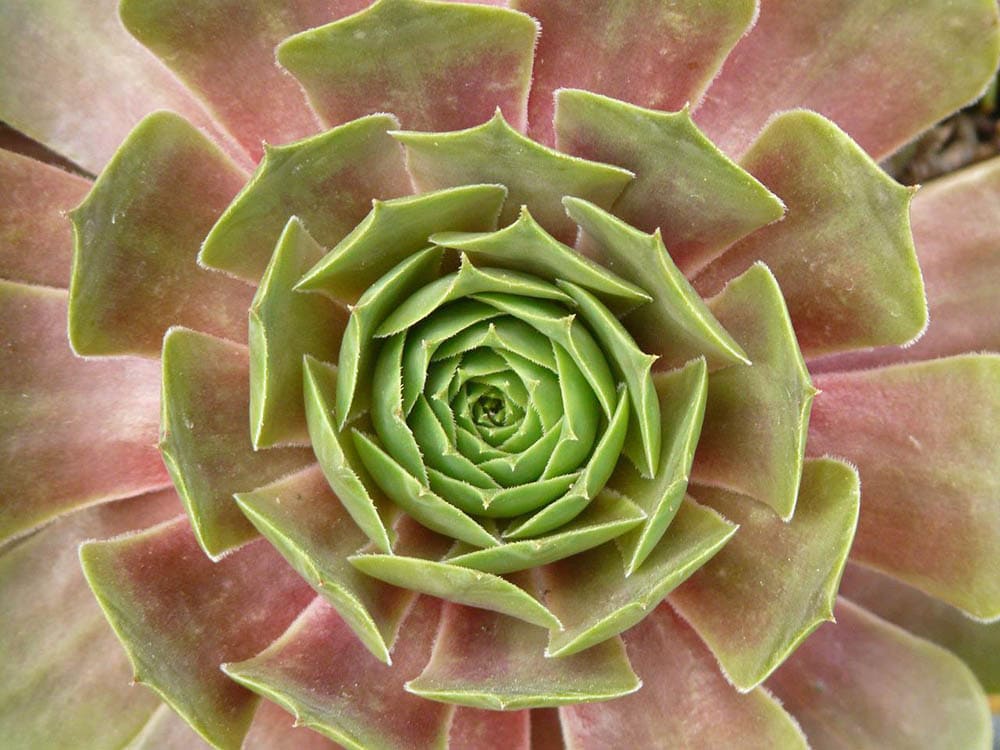
| Botanical name: | Sempervivum |
| Native area: | Europe, Morocco, and western Asia |
| Soil Type: | Well-drained, gritty soil |
The Houseleek is one of the most common succulents. It has green leaves with purple points. Each rosette on this succulent is monocarpic, which means that after flowering, the rosette dies. Although the plant is native to southern Europe, it is grown throughout the continent because of its distinctive look.
Houseleek is an evergreen succulent plant that produces thick and enormous rosettes of green leaves. It’s a simple to cultivate, resilient, and long-lasting plant. The Houseleek prefers full to partial sun with some afternoon shade and well-drained soil.
- It can help treat skin burns
- When ingested, it treats diarrhea
- Hardy
- May help improve the immune system
- Can develop fungal disease
- Prone to crown rot
Conclusion
We hope we gave you some insight into which succulent is perfect for bringing into your home. Each of these plants has specific needs and a unique appearance, and any is ideal for keeping in or around your home.
- Zebra Plant: Indoor Care & Growing Guide
- Haworthia: Plant Care & Growing Guide
- Echeveria Info, Photos & Varieties
- Succulents Box
- How to Care for a Jade Plan
- How to Care for Aloe Vera Plants
- Succulent City
- How to Care for Snake Plants
- Plant Profile for Sedum acre ‘Aureum’ – Golden Stonecrop Perennial
- Have You Ever Heard Of The Whale’s Tongue ‘Agave Ovatifolia’?
- The Rounded Ball Cactus— Parodia Magnifica | Succulent City
- Red Edged Pig’s Ear, Cotyledon orbiculata | High Country Gardens
- Aeonium ‘Zwartkop’ – BBC Gardeners World Magazine
- String Of Pearls Plant – Tips For Growing A Rosary String Of Beads Plant
- https://www.succulentsandsunshine.com/types-of-succulents/aeonium-sunburst/
- Aeonium Sunburst Care: Tips On Growing The Sunburst Succulent
- How to Grow and Care for Sweetheart Hoya | Gardener’s Path
- Sempervivum Tectorum Care: How To Grow Common Houseleek
Featured Image Credit: dyturge, Pixabay
Contents



